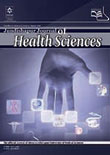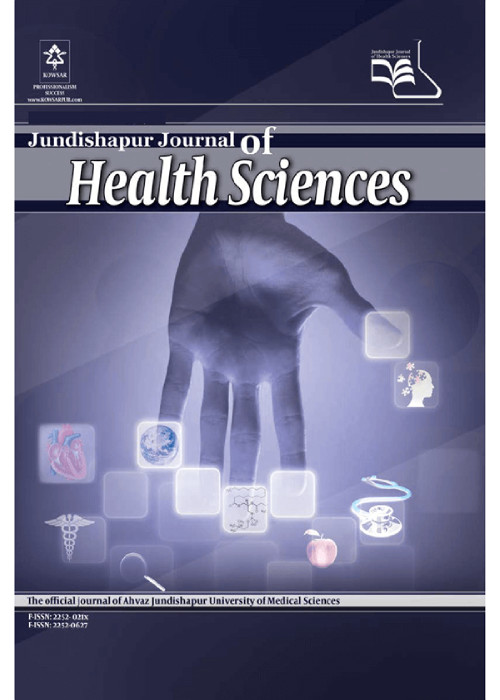فهرست مطالب

Jundishapur Journal of Health Sciences
Volume:10 Issue: 3, Jul 2018
- تاریخ انتشار: 1397/04/20
- تعداد عناوین: 7
-
-
Page 1BackgroundNowadays, water pollution by toxic elements has become a universal environmental issue. Lead, as a toxic element, is approximately enhanced in the environment by industrial development. The potential risk of lead to health has attracted the interest of researchers to eliminate it from contaminated water.ObjectivesIn the present study, a dithizone-modified bagasse adsorbent, used for removing lead ions from aqueous solutions, was successfully prepared.MethodsThe prepared adsorbent was characterized by FT-IR and XRD techniques. The adsorptive properties of adsorbent were studied at room temperature. Different parameters like pH value, solution concentration, adsorption time, and amount of adsorbent were optimized.ResultsResults show that the adsorption of lead on dithizone-modified bagasse fitted well to the Freundlich isotherm equation following the Langmuir isotherm. The maximum removal efficiency was obtained to be more than 99.5% in a short contact time (1.0 minutes) at pH 6. The loading capacity was studied and obtained to be 37.20 mg g-1. The adsorption process was replicated for 4 times without a considerable loss in its efficiency (> 95%).ConclusionsHigh efficiency at a short time, recyclability, and biodegradability are the main advantages of this adsorbent. The proposed method is cost-effective and environmentally friendly.Keywords: Lead, Bagasse, Dithizone, Adsorption, Water Treatment
-
Page 2BackgroundIndoor dust as a significant source of pollution in the urban environment can cause serious ecological and health problems. Therefore, the current study has been conducted to determine the Cadmium, Chromium, Lead, and Nickel contamination in house dust in the city of Khorramabad in 2017.MethodsA total of 80 samples of indoor dust were collected from 20 regions of the study area. After sample digestion, the content of metals was determined using the inductively coupled plasma-optical emission spectrometer (ICP-OES).ResultsBased on the results, the average contents of Cd, Cr, Pb, and Ni (mg/kg) in the analyzed dust samples were 11.34 ± 2.25, 11.81 ± 5.29, 32.08 ± 20.60, and 60.19 ± 17.90, respectively. Also, comparison of the element levels in the house dust samples with the maximum permissible concentrations (MPC) established by environmental protection agency (EPA) shows that the average levels of Cd and Ni were higher than the MPC.ConclusionsDue to average contents of elements in the dust samples, especially Cd and Ni, were higher than the MPC; the indoor dust can cause adverse effects on human health. Therefore, control of the anthropogenic sources that cause discharge of hazardous compounds, particularly toxic heavy metals into the outdoor, indoor, and street dust, is recommended.Keywords: Health Impacts, Heavy Metals, Indoor Dust, Khorramabad City
-
Page 3BackgroundInforming the target population plays an important role in medical tourism attraction and should be managed in order to incorporate all appropriate tools to increase it. The aim of this study was to determine the requirements and basis of a medical tourism website for hospitals.MethodsThis study was a cross sectional analytical study that was performed during year 2018 amongst hospital managers and faculty members of Iranian medical sciences universities that have the potential to attract medical tourism. Data gathering was done by a self-made questionnaire. From 120 questionnaires, which were distributed between samples, 82 were gathered completely. Data analysis was done by SPSS version 16 and descriptive (mean, frequency and etc.) and analytical (one-way ANOVA) statistical tests.ResultsThe results of the study showed that from the experts point of view, the most important requirement and basis of Hospital Medical Tourism Websites) HMTW(was photo gallery (mean = 4.44) and a general guide for patients (mean = 3.85) was the least significant element in HMTW. Also, there was no difference between faculty members, staff, and different genders regarding views about HMTW items (P = 0.11).ConclusionsBased on the results, it was suggested that the results of this study could be used by policymakers of medical tourism and HMTW developers. Also, the results of this study could be used as an evaluation tool for investigating hospital websites regarding medical tourism attraction abilities.Keywords: Medical Tourism, Hospitals, Website, Tourism Attraction
-
Page 4BackgroundDuring the paint spraying process in the automotive industry, a variety of wastes, including a large amount of paint sludge is produced, which contains a variety of hazardous substances, such as BTEX and heavy metals. The aim of the present study was vermicomposting of paint sludge with sewage sludge and Eisenia fetida as earthworm spices for reduction of heavy metals.ObjectivesVermicomposting process employing earthworms is increasingly being used for conversion of both sewage and some industrial wastes to reduced heavy metals and volatile solid content in bulk of solid wastes. Therefore, in this study, feasibility of chromium removal from paint sludge by using Eisenia fetida worms was investigated.MethodsIn this study, the quantitative and qualitative characteristics of paint and biological sewage sludge waste were determined in terms of Cr, moisture content, nitrogen and carbon, C/N ratio, pH and temperature. Then the paint sludge was mixed in various proportions with the thickening biological sewage sludge of Saipas sewage treatment plant. The decomposition time for the vermicompost samples for each run was 90 days. In order to analyze various parameters, including Cr and volatile solids reduction, sampling from each pilot was performed on 1, 15, 30, 50, 70 and 90 days. The Cr measurements were performed using the AASM method. The paint sludge and sewage sludge were mixed in different ratios. After the mixing, 500 adult Eisenia fetida earthworms were introduced to each box.ResultsThe results showed that the optimum removal rate for Cr was found in the mixing ratio of 6 kg of biological sludge with 600 g of paint sludge and in this ratio, the amount of Cr concentration fell from 6 mg/kg to less than 0.2 mg/kg in 90 days. In addition, in the same ratio of sludge mixing, the C/N ratio ranged from about 27 on the first day to 14.3 on day 90 and the pH decreased from 7.8 on the first day to 7.3 on the 90th day. Volatile solids decreased from 80.4% on the first day to 37% on the 90th day.ConclusionsVermicomposting is a good alternative for treating paint sludge with biological sludge, and is advantageous for reduction of pollutants purposes. Research was carried out on bioavailability of heavy metals such as Cr during vermicomposting for 90 days using Eisenia fetida earthworms. Finally, the results showed that, Eisenia fetida could eliminate Cr in low levels.Keywords: Chromium, Automotive Industry, Biological Sludge, Paint Sludge, Vermicompost
-
Page 5BackgroundCimex lectularius belongs to the family of Cimicidae and its infestation to the man is a public health problem. Recently, bed bug infestation increased world-wide. Psychological distress is one of the bed bug infestations. Regarding its biting, awareness and knowledge are the keys to reduce bed bug prevalence in the society.ObjectivesThe current study aimed at evaluating of this investigation was to evaluate awareness, and knowledge of residents toward the bed bug in southwest Southwest of Iran.MethodsThe current descriptive cross sectional study was conducted on Ahvaz residents, from June to July 2016. The questionnaire consisted of demographic characteristics, identification, knowledge about the bed bug, and awareness related to the prevention and control of the insect completed by 180 participants. Collected data were analyzed with SPSS version 16.ResultsA total of 180 participants were divided into three groups that responded to the questions. The findings showed that the percentage of correctly identify the bed bug in a vial, in three groups of respondents in Ahvaz city, people, medical and pharmacy students and health workers were 13%, 25%, and 72%, respectively. The results showed that 55% of participants were male. A few of the respondents were illiterate and most of them were in the age range of 20 - 29 years approximately, 13%, 25%, and 72% of the residents, university students and health staff knew the bed bug, respectively. Totally, 72% of health workers and 33% of students had good knowledge about the prevention of the insect, respectively. The results revealed that 92% of health workers were very concerned about bed bug infestation. The habitat of C. lectularius was recognized by 78% of health staff, while 23% of people did not know the pest.ConclusionsScarce knowledge of people on nuisance insect, C. lectularius, is one of the critical causes of high infestation in Ahvaz.Keywords: Bed Bug, Nuisance Insect, Awareness, Urban Pest
-
Page 6BackgroundEscherichia coli is recognized as a common cause of infection. Long-lasting presence of bacteria on biotic and abiotic surfaces and failure of bacterial eradication are predicted by biofilm production. Some extracellular frills of E. coli can be implicated in productive events, leading to biofilm formation by surface colonization.ObjectivesIn the present study, correlation of csgA (encoding curli fimbriae) and fimA (encoding a large subunit of type I fimberiae) gene expression with biofilm formation of extraintestinal bovine pathogenic E. coli strains was evaluated in different enrichment media.MethodsThe microtiter plate-based crystal violet method was applied to examine the biofilm production of 30 E. coli strains in Luria-Bertani (LB) and Brain-Heart Infusion (BHI) broth with 1% sucrose. PCR assay was performed to determine the presence of the studied genes.ResultsAccording to the results, 100% of isolates contained csgA genes, and 96.7% contained fimA genes. Using the BHI medium with 1% sucrose, 53.3% and 16.6% of strains were average and strong biofilm producers, respectively. On the other hand, by using the LB medium, 66.6% of isolates were poor biofilm producers, whereas none were strong biofilm producers.ConclusionsThe BHI medium containing 1% sucrose was better detected in biofilm production, compared to the LB medium. Since the studied genes were present in non-biofilm producing isolates, the correlation of these genes with biofilm-producing ability is questioned.Keywords: Escherichia coli, Biofilm, Microtiter Plate Crysal Violet
-
Page 7BackgroundHuman capital is one of the key factors in sustainable development, and health is an important part of human capital. According to this, a major goal of the Fifth and Sixth Development Plans in Iran was the establishment of regional equilibrium and justice as well as reduction of inequality in health indicators.ObjectivesThis research aimed at ranking and comparing Iranian provinces in terms of the level of development of health indicators and the utilization of resources in the final year of the Fifth Plan (2015).MethodsFollowing the objectives of the research and based on 17 indicators, the Technique for Order of Preference by Similarity to Ideal Solution (TOPSIS) method was applied to calculate and compare provincial development level in health indicators during year 2015. Besides, the Moran test was used to examine the impact of development of health indicators in a province on neighboring provinces’ indicators.ResultsIn the final year of the Fifth Plan (2015), among thirty-one provinces studied, Semnan and Khuzestan had the highest and the lowest levels of healthcare development in the country, respectively. In this area, the five provinces of Semnan, Markazi, Yazd, and Southern Khorasan were respectively the most benefited while Qom, Kerman, Sistan and Baluchestan, Alborz, and Khuzestan were the most deprived provinces of the country. Also, an inverse relationship was found between greater concentration of resources in a region and less resources and benefits in neighboring areas.ConclusionsThe ranking and comparison of the level of development of health indicators in provinces at the end of the Fifth Program indicated that healthcare resources and facilities were distributed unequally. If the distribution pattern is not improved, greater concentration of facilities in more beneficial areas will lead to further weakening of neighboring areas. According to the results, Qom, Kerman, Sistan and Baluchestan, Alborz, and Khuzestan provinces had less access. Therefore, due attention is needed by policy-making on these indicators. The type of indicators showed that the environmental conditions in Khuzestan, especially the problem of microorganisms in the air, have generated reluctance among physicians to work in these areas. Therefore, in addition to reviewing resource allocation as revealed by the indicators, it is necessary to use incentive levers to compensate for these problems.Keywords: Health, TOPSIS Method, Moran Coefficient, Provinces of Iran


